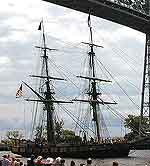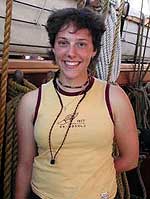By Stephanie Hemphill
Minnesota Public Radio
August 2, 2002
The tall-masted sailing ship Niagara is visiting Duluth August 1-5. During the War of 1812, the original Niagara helped defeat the British in the Battle of Lake Erie. Commodore Oliver Hazard Perry made his famous remark, "We have met the enemy and they are ours," from the deck of this ship. The original Niagara was built in Erie, Penn. The replica is part of a living museum collection, and it's on a tour around the Great Lakes.
| |
|
|
|
||
The Niagara made her way through the Duluth ship canal using her diesel engines. She greeted the crowd with three blasts from her cannons.
Later, she tied up along Duluth's Lakewalk just behind the convention center. All evening, people came to admire the ship. No one here has seen the Niagara under sail, but they're in love with her anyway.
Local people and visitors stand and admire her tall masts and graceful shape. On board the ship, you notice the smooth wooden deck and the brightly painted bulwarks or side walls.
Two earlier replicas of the Niagara rotted. Capt. John Beebe-Center says sailing the ship actually keeps her in better shape.
"She's seeing a lot more water pass under her keel," he says. "But because we have the crew on board, we're able to keep up with the little bits of wood rot and things like that we find, and repair them before they become an issue. So by voyaging her we keep her alive," Capt. Beebe-Center says.
| |
|
|
|
||
About half the 40-member crew are professional sailors, and the other half are volunteers. Neil Garneau has been a volunteer deckhand for several summers. In the winter, he's a museum curator.
Garneau says for most volunteers it takes a little time to get used to climbing the masts. They jut skyward from the main deck, as high as a 12-story building.
"But whenever we're up there, we're there for work," Garneau says. "Normally just handling sail - taking in sails or letting loose sail."
Garneau says concentrating on the job at hand takes the focus off how high you are. At night the volunteer sailors climb down a short set of stairs to the berthing deck, where they eat and sleep.
Garneau warns visitors, "Watch your head, there's only five feet of clearance at the bottom!"
| |
|
|
|
||
Even a small person can't stand up in this space. It's low and dark. Canvas bags stuffed with personal gear hang from pegs on the walls. Twenty-five people cram into this space to sleep and eat.
"About half the people that live in this room sleep in hammocks," Garneau explains. "The rest of the crew that live down here sleep on the 'sole' or the floor. So with people above you and sleeping below, it's very difficult to get around at night, with very narrow passages."
Volunteers must commit to spending at least three weeks on the Niagara. College student Lillian Gehres says she's learned a lot by living in such close quarters with her crewmates.
"You have to learn how to accept differences and make yourself open to new ideas," she says. "That really helps to make the whole berth deck - 30 people crammed down there - experience work for you."
This is the first time the Niagara has sailed in Lake Superior, and Gehres says the showers are a little chilly. Fire hoses pump water from Lake Superior onto the shivering crew on deck.
"We just use the fire hose. Someone climbs up the scaffolding and holds it above head, we all just take a turn, hold our breath and go for it. We lather up, rinse off, and then we're done," she says.
Gehres says since she came aboard the Niagara she's been thinking about becoming a teacher on a teaching vessel. She says it's a great way to learn.
"I'm actually hauling on a line and I see the sail go up, then I see the wind catch it and then I see the ship move, and I'm like 'wow, this is pretty awesome.'"
The Niagara will head to Marquette, Mich. after her visit to Duluth.
More Information


